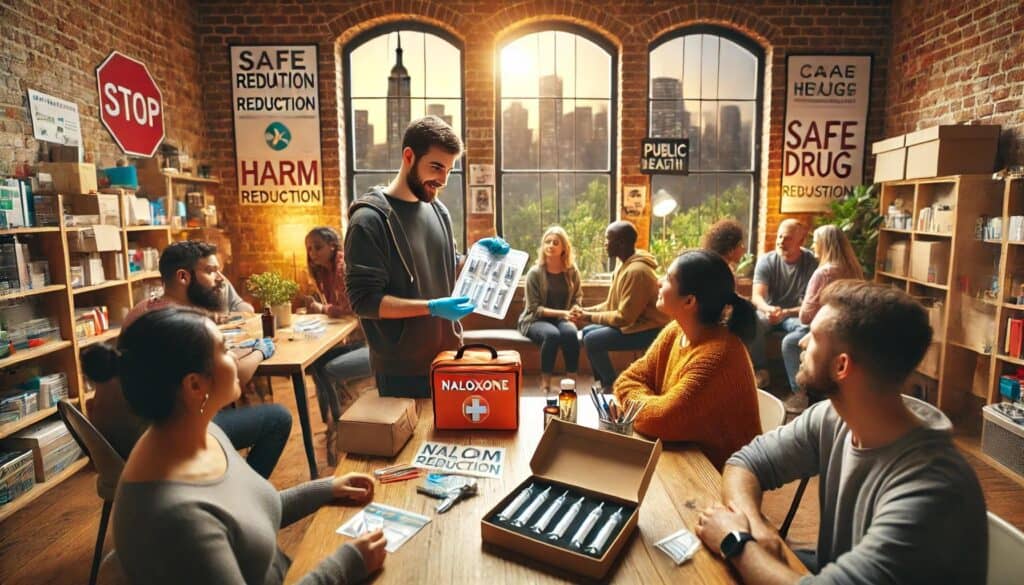Introduction
Harm reduction is a set of practical strategies and ideas to reduce negative consequences associated with substance use. Harm reduction does not require total abstinence but rather decreasing harm from the use of substances for the person and the community. The harm reduction approach views people as those who still ought to be supported and resources provided if they refuse or are unable to stop using drugs or alcohol. At Virtue Recovery Center, we believe in providing the correct information to help people make the best choices for their health and well-being.
Key Takeaways
Harm reduction is a compassionate, practical approach to minimizing the negative effects of drug and alcohol use without requiring abstinence.
Core principles of harm reduction include respect for individual autonomy, non-judgmental support, and meeting people where they are in their substance use journey.
Medication-assisted treatment (MAT) and naloxone distribution are vital harm-reduction strategies for reducing opioid overdose risks and supporting recovery.
Harm reduction does not enable drug use but rather provides life-saving support, and evidence shows it does not increase drug dependency.
Harm reduction reduces stigma around addiction, offering a non-judgmental pathway to treatment and healthier choices.
Let’s take a closer look at defining harm reduction, why it’s important, and how it applies to drug and alcohol addiction management.
Core Principles of Harm Reduction
Respect for Individual Autonomy: Harm reduction is based on the conviction that people have the right to make autonomous choices about their lives, including the risk of using drugs. It doesn’t force users to stop, but it provides options to mitigate the harms of use.
Nonjudgmental and Non-Coercive: This method does not label people as failures for not following abstinence-based goals. It doesn’t judge but provides services and support as substance use is, as a whole, very complex.
Meet People Where They Are: Harm reduction acknowledges that people use drugs and alcohol for different reasons, social, emotional, or psychological. It doesn’t advocate for total abstinence but rather supports people wherever they are on their substance use journey, whether actively using or thinking about cutting down or stopping.
Evidence-Based Interventions: Harm reduction strategies are based on research and evidence. For instance, needle exchange programs and supervised consumption sites, medication-assisted treatments, and the provision of safe spaces to prevent overdoses – are proven methods.
Harm Reduction Strategies
1. Needle Exchange Programs (NEPs):
NEPs are one of the most well-known harm reduction strategies, providing clean syringes to people who inject drugs, reducing the risk of contracting blood-borne diseases such as HIV and hepatitis C. Many of these programs also refer people to health services, addiction treatment, and social support services to help people stay healthy.
2. Supervised Injection/Consumption Sites:
Supervised sites are a controlled environment where people can use substances under the supervision of medical professionals. By providing immediate medical intervention if needed and decreasing the spread of infectious diseases, these sites help to prevent overdose deaths. They also function as a bridge to bring users to healthcare, addiction treatment, and social services.
3. Medication-Assisted Treatment (MAT):
MAT refers to using medicine like methadone, buprenorphine, or naltrexone while a person is withdrawing from opioids or becoming dependent on opioids. Because these medications decrease cravings and withdrawal symptoms, people are more likely to manage their addiction and take fewer risks of overdose.
4. Naloxone Distribution:
Naloxone (or Narcan) is a life-saving medication that can reverse opioid overdoses. Naloxone kits are often distributed to people who use opioids, their families, and communities through harm reduction programs. Almost everywhere, naloxone availability has resulted in a dramatic decrease in overdose deaths.
5. Safe Alcohol Consumption Practices:
Harm reduction approaches for those with alcohol dependency might involve giving out the resources of resources like designated driver programs, alcohol use in housing and “wet” shelters, and alcohol programs that don’t focus on abstinence but on lowering drinking to safer levels.
6. Education and Information:
Education about safer drug and alcohol use practices is also part of harm reduction. It may include information on how to avoid overdose, reduce the risks of infectious diseases, and provide accurate information about the substances themselves.
What Are the Benefits of Harm Reduction?
Harm reduction programs offer several important benefits, including:
Reduction in overdose deaths: By providing supervised consumption sites, naloxone, and safer use supplies, harm reduction directly reduces the likelihood of fatal overdoses.
Improved public health outcomes: Needle exchange programs and education on safer use practices help reduce the transmission of diseases like HIV and hepatitis C, benefiting individuals and the broader community.
Access to treatment: Many harm reduction programs serve as an entry point for individuals to access addiction treatment, healthcare, mental health services, and other social supports.
Reduced stigma: Harm reduction fosters a compassionate and non-judgmental environment where people can seek help without fear of punishment or shame. This can reduce the stigma associated with addiction, making it easier for individuals to seek support when they are ready.
Cost-effectiveness: Harm reduction interventions are often more cost-effective than punitive or abstinence-only approaches. Programs like needle exchanges and supervised injection sites save money by reducing healthcare costs associated with overdoses, infectious diseases, and emergency room visits.
Criticisms of Harm Reduction
Although proven to be beneficial, harm reduction has been criticized, sometimes by those who think it encourages substance use rather than helping people to stop. Others claim that harm reduction efforts could be viewed as ‘normalizing’ drug use or as a ‘safety net’ that discourages people from seeking abstinence-based recovery. However, research shows that harm reduction doesn’t lead to more drug use or dependence. Rather than offering a compassionate response, it reduces risk and saves lives.
How Virtue Recovery Center Can Help
At Virtue Recovery Center, we understand that every person’s recovery journey is unique. Whether you’re trying to decide if the California Sober approach is right for you or if you’re ready to take steps toward total sobriety, we’re here to help.
Our addiction treatment programs are designed to meet each person’s individual needs. Here’s how we can help:
- Personalized Treatment Plans: We provide detoxification, counseling, and aftercare services, depending on the client’s needs.
- Therapy and Counseling: Our professional therapists work with you to understand the root causes of your substance use and teach you healthy ways to cope with stress, cravings, and triggers.
- Long-Term Support: Recovery does not stop as soon as treatment is over. We offer aftercare and support to ensure you remain sober and create a better life.
At Virtue Recovery Center, we want to make sure that you get the best chance at recovery, and that means without having to use substances.
Conclusion
Drug and alcohol addiction is being addressed innovatively and humanely through harm reduction. Instead of looking at abstinence as the sole solution, it offers people the tools and support to facilitate the mitigating of the negative results of their substance abuse. Harm reduction saves lives by meeting people where they are and helping people take steps towards healthier, more fulfilling lives at their own pace. Its public health and evidence-based practices make it essential to modern addiction management.
If you or your family member needs help, contact Virtue Recovery Center at 866-461-3339 to get more information about our substance abuse treatment and how we can assist you in the process of recovery.
Frequently Asked Questions (FAQ):
Q: What is harm reduction in addiction management?
A: Harm reduction is an approach that focuses on minimizing the negative consequences of drug and alcohol use rather than requiring complete abstinence. It emphasizes practical strategies to improve health and reduce harm, such as needle exchanges and overdose prevention.
Q: How does harm reduction differ from abstinence-based treatment?
A: Harm reduction allows individuals to continue using substances while taking steps to reduce the associated risks. Unlike abstinence-based treatment, it does not require individuals to stop using drugs or alcohol but supports them in making safer choices.
Q: What are examples of harm reduction strategies?
A: Common harm reduction strategies include needle exchange programs, supervised injection sites, medication-assisted treatment (MAT), naloxone distribution, and providing education on safer substance use practices.
Q: Does harm reduction encourage drug or alcohol use?
A: No, harm reduction does not promote substance use. It provides support and resources to reduce the harms of drug and alcohol use, helping individuals stay safer and healthier without increasing dependency.
Q: Why is harm reduction important in public health?
A: Harm reduction is essential in public health because it lowers overdose deaths, reduces the transmission of diseases like HIV and hepatitis C, and connects individuals to healthcare and addiction treatment services, improving overall community well-being.
Resources
https://nida.nih.gov/research-topics/harm-reduction
https://www.axios.com/2024/04/19/420-alcohol-alcoholism-marijuana-cannabis-booze-weed-pot



























